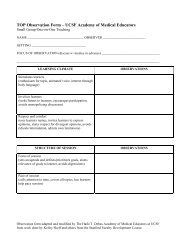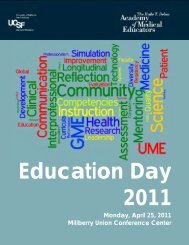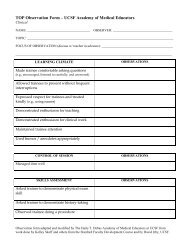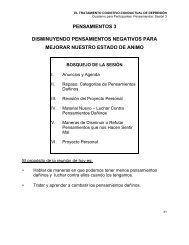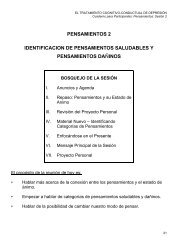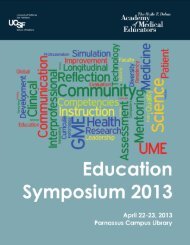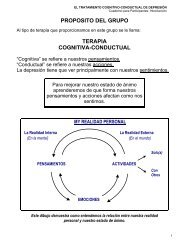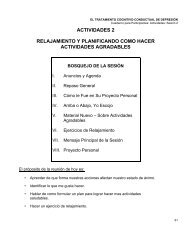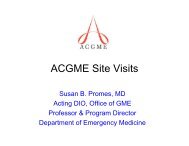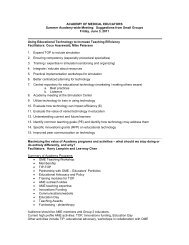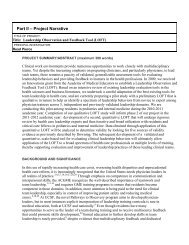Download a pdf of the notes from all sessions - UCSF School of ...
Download a pdf of the notes from all sessions - UCSF School of ...
Download a pdf of the notes from all sessions - UCSF School of ...
You also want an ePaper? Increase the reach of your titles
YUMPU automatically turns print PDFs into web optimized ePapers that Google loves.
Academy <strong>of</strong> Medical Educators – Winter Meeting<br />
February 3, 2012<br />
Sm<strong>all</strong> Group Discussion<br />
Session A - 3:45-4:15 pm<br />
• Engaging with <strong>the</strong> Educational Wing <strong>of</strong> your Pr<strong>of</strong>essional Society: Why, When<br />
and How (Hyland, Topp, Harper, Shinkai)<br />
• Technology and Teaching in <strong>the</strong> Clinical Environment: The iPad, APeX and<br />
Beyond (Teitel, Wamsley)<br />
• Adventures in Assessment (Teherani, Promes)<br />
Session B - 4:20-4:50 pm<br />
• Linking Education and Clinical Quality (Green, Young)<br />
• New Curricular Content for <strong>the</strong> 21st Century (Reeves, Lai, Aronson)<br />
• Novel Uses <strong>of</strong> Educational Technology (Video, ARS, etc.) (Burke, Mayfield, Lin)<br />
Notes <strong>from</strong> each session follow, with resources as applicable and a partial list <strong>of</strong><br />
participants.<br />
Please contact Cynthia Ashe at ashec@medsch.ucsf.edu if you participated in one <strong>of</strong> <strong>the</strong><br />
groups and wish to have your name added.<br />
Best viewed with Adobe Reader; set to “page view”. 1 <strong>of</strong> 16
Engaging with <strong>the</strong> Educational Wing <strong>of</strong> Your Pr<strong>of</strong>essional Society: Why,<br />
When and How<br />
Facilitators: Mike Harper, MD; Kathy Hyland, PhD; Kanade Shinkai, MD, PhD; Kim Topp, PT,<br />
PhD<br />
Participants:<br />
• Chen, Lee-may<br />
• Dhaliwal, Gurpreet<br />
• Diab, Mohammad<br />
• Fernandez, Alicia<br />
• Jain, Sharad<br />
The Question<br />
What is <strong>the</strong> best way to interact with <strong>the</strong> educational sector <strong>of</strong> a pr<strong>of</strong>essional society to meet <strong>the</strong><br />
goal <strong>of</strong> getting specialized content (i.e. orthopedic surgery, dermatology) into <strong>the</strong> medical school<br />
curriculum?<br />
Topics <strong>of</strong> Discussion<br />
What?<br />
How?<br />
Why?<br />
• Get more lecture time (ch<strong>all</strong>enging)<br />
• Online modules<br />
o pros: can be integrated into established rotations/ courses, easy to create, easy<br />
to collaborate<br />
o cons: a cop-out/ not ideal learning tool, asks students to do it on <strong>the</strong>ir own time if<br />
not integrated into a course or mandatory<br />
• Ways to contribute to your society’s efforts to develop national curricula and <strong>the</strong><br />
ch<strong>all</strong>enges <strong>of</strong> incorporating such curricula into one’s home institution<br />
• Ch<strong>all</strong>enges <strong>of</strong> assigning curricula developed within pr<strong>of</strong>essional organizations to preclinical,<br />
clinical and GME levels <strong>of</strong> training<br />
• Creating national standardized curriculum (derm as example)<br />
• May be able to create a curriculum that is <strong>the</strong>n integrated into o<strong>the</strong>r non-specialized<br />
curriculum<br />
• Example #1: on-line modules in dermatology relevant to pediatrics can be moved into<br />
pediatrics rotation<br />
• Example # 2: through pr<strong>of</strong>essional society (i.e. geriatric medicine), establish<br />
competencies through consensus conference, get <strong>the</strong>m endorsed by AAMC, and <strong>the</strong>n<br />
use <strong>the</strong>se to start conversations with o<strong>the</strong>r disciplines (family practice) to initiate<br />
collaborations to create curriculum toge<strong>the</strong>r<br />
• Who gains?<br />
o Programs that have less established curriculum or no curriculum can learn<br />
through shared experience joining forces with more established curriculum; i.e.<br />
don’t reinvent what’s already been created.<br />
o Anatomists/clinical anatomists: sharing information re: trends, problems/solutions<br />
2 <strong>of</strong> 16
o Gain strength in #’s: i.e. gyn onc -> sm<strong>all</strong> programs (with 1-2 trainees) joining<br />
forces to do something for <strong>the</strong> larger group <strong>of</strong> trainees -> such as group skills<br />
training at <strong>the</strong> pr<strong>of</strong>essional society meeting<br />
• Who loses? “special” programs have more to lose than <strong>the</strong>y gain because <strong>the</strong>y share<br />
something <strong>the</strong>y created with programs in need (but nothing to <strong>of</strong>fer back)<br />
Final thoughts:<br />
• Group member reiterate that coming <strong>from</strong> <strong>UCSF</strong> -> we are able to contribute a lot <strong>of</strong><br />
insight and resources at <strong>the</strong> pr<strong>of</strong>essional society meetings and are <strong>of</strong>ten actively<br />
contributing members<br />
• Need to consider whe<strong>the</strong>r <strong>of</strong>fering competencies is enough. How do you translate<br />
competencies into curriculum?<br />
3 <strong>of</strong> 16
Technology and Teaching in <strong>the</strong> Clinical Environment: The iPad, APeX<br />
and Beyond<br />
Facilitators: David Teitel, MD; Maria Wamsley, MD<br />
Participants (partial list):<br />
• Aronson, Louise<br />
• Burke, Christian<br />
• Cooke, Molly<br />
• Gelb, Alan<br />
• Mayfield, Chandler<br />
• Poncelet, Ann<br />
• Sanchez, Henry<br />
• Souza, Kevin<br />
• Steinauer, Jody<br />
Key Discussion Points:<br />
• Access to EMR<br />
• Access to personal and shared data<br />
• Medical information/Educational tools<br />
• Interaction with peers and team members<br />
• Evernote as a way <strong>of</strong> keeping track <strong>of</strong> learning issues<br />
• CANTO on iPAD; HAIKU on iPHONE<br />
• Medical records currently used as a repository, not able to collect interesting cases in a<br />
file.<br />
• Creating a teaching case – is <strong>the</strong>re a way to tag it with key words so you can search for it.<br />
• HEAL library was a mechanism for being able to tag cases, but according to Kevin Souza,<br />
this may soon be defunct.<br />
• Consider <strong>the</strong> idea <strong>of</strong> <strong>the</strong> Academy creating our own asset library.<br />
• iBOOK author<br />
• Could put syllabi into <strong>the</strong> iPAD (preclinical years) – KNO a platform that will work across<br />
devices<br />
Resource: See slide set that follows<br />
4 <strong>of</strong> 16
Academy <strong>of</strong> Medicine<br />
Winter Meeting 2012<br />
Technology and Teaching in <strong>the</strong> Clinical Environment<br />
David Teitel, MD
Areas <strong>of</strong> Interest<br />
• Access to EMR<br />
• Access to personal and shared data<br />
• Medical Information/Educational<br />
tools<br />
• Interaction with peers and team<br />
members
Access to EMR<br />
• Control remote terminal<br />
✦<br />
UCare, WebESA, Muse, PACS, etc<br />
‣ rdc: Desktop Connect, iTeleport etc<br />
✦<br />
APeX<br />
‣ citrix session: Citrix Receiver<br />
• Local App<br />
✦<br />
Epic Canto/Haiku
Access to Data<br />
• Local<br />
✦<br />
within various apps<br />
‣ QuickOffice, Docs to Go, Keynote, etc<br />
• Distant<br />
✦<br />
Existing servers (P, S and T drives, own<br />
computer, SOM, etc)<br />
‣ File Browser<br />
✦<br />
Cloud storage - DropBox, iCloud, etc
Information<br />
• General Medical Information<br />
✦<br />
LexiComp, PALS Advisor, Epocrates,<br />
Medscape<br />
• Teaching Tools<br />
✦<br />
iRocket, eBrary, individual Apps, iBooks<br />
Textbooks
Interaction<br />
• Social Media<br />
✦<br />
CLE, Wiki@<strong>UCSF</strong>, Doximity
Adventures in Assessment<br />
Facilitators: Arianne Teherani, PhD; Susan Promes, MD<br />
Participants (partial list):<br />
Autry, Meg<br />
Brzezinski, Marek<br />
Cardis, Betsy<br />
Hauer, Karen<br />
Loeser, Helen<br />
Lowenstein, Dan<br />
McCowin, Marcia<br />
Reeves, Scott<br />
Ru<strong>the</strong>rford, George<br />
Key Discussion Points:<br />
• Individualization<br />
o Individualizing assessments based on a learners’ level <strong>of</strong> prior knowledge<br />
and expertise.<br />
o How feasible is that?<br />
o How does that play into ensuring students achieve competency?<br />
• Standardization (Validity)<br />
o Assessments should be standardized, particularly in areas where <strong>the</strong>y<br />
currently are not (e.g. clerkship evaluations, MSPEs).<br />
o Language should be provided that would ensure consistent focus on<br />
specified skills and knowledge (competencies) for <strong>all</strong> learners.<br />
o Efforts to standardize must be validated against o<strong>the</strong>r markers <strong>of</strong><br />
performance.<br />
• Multiple tools; Triangulate evidence (Portfolio)<br />
o Assessment should be derived <strong>from</strong> multiple sources and never rely heavily<br />
on a few sources that are measuring 1 or 2 outcomes.<br />
o The portfolio provides for important venue <strong>of</strong> self-assessment, which can be<br />
subsequently channeled to provide individualized and aligned teaching to our<br />
learners.<br />
• What are we measuring?<br />
• What are <strong>the</strong> outcomes we care about?<br />
• Assessment drives learning<br />
o Assessment is ultimately a soci<strong>all</strong>y constructed outcome.<br />
o The value we place as a society and as educators on those outcomes<br />
provides it with meaning.<br />
o Assessment should be used primarily to prompt and ensure learning.<br />
• Identifying competency<br />
o Ensuring that assessments designed are in fact valid and sensitive enough to<br />
identify how competent our learners are.<br />
o Also ensuring that competencies and not focusing on and perpetuating <strong>the</strong><br />
culture minimum standards.<br />
11 <strong>of</strong> 16
Linking Education and Clinical Quality<br />
Facilitators: Adrienne Green, MD; John Young, MD<br />
Participants (partial list):<br />
• Brzezinski, Marek<br />
• Campbell, Andre<br />
• Chen, Lee-may<br />
• Chou, Calvin<br />
• Josephson, Andy<br />
• Loeser, Helen<br />
• Maa, John<br />
• Marmor, Andi<br />
• Masters, Susan<br />
• Robertson, Patty<br />
• Rollins, Mark<br />
• Sehgal, Niraj<br />
• Topp, Kim<br />
• Vener, Margo<br />
Key Discussion Points:<br />
• This topic <strong>of</strong>ten has a tendency to go <strong>of</strong>f in one <strong>of</strong> two directions:<br />
o What is <strong>the</strong> relationship (<strong>of</strong>ten assumed to be a benefit by educators) <strong>of</strong> having<br />
learners in clinical settings and how can we document it effectively? and<br />
o What do learners need to know and experience about <strong>the</strong> field <strong>of</strong> PS/QI and<br />
what it is <strong>the</strong> best way to create <strong>the</strong>se learning opportunities?<br />
• There is considerable interest on <strong>the</strong> part <strong>of</strong> learners in developing QI/PS skills, driven by<br />
intrinsic interest and <strong>the</strong> fact that new residency graduates are <strong>of</strong>ten <strong>of</strong>fered positions that<br />
include a QI role. The Department <strong>of</strong> Medicine has developed several responsive<br />
programs:<br />
o Two-week procedures/QI&PS rotation that every medicine intern does;<br />
o<br />
o<br />
A QI/PS elective for residents and, coming on line, one for students;<br />
A highly subscribed “Quality and Safety Ch<strong>all</strong>enge” that encourages and<br />
showcases mentored resident projects.<br />
• Multi-site programs have <strong>the</strong> significant ch<strong>all</strong>enge <strong>of</strong> minimizing unwanted redundancy<br />
and optimizing cohesion when <strong>the</strong>ir trainees rotate through multiple hospital systems,<br />
each <strong>of</strong> which has its own approach to QI/PS, hand<strong>of</strong>fs, EMR, etc.<br />
o The Department <strong>of</strong> Medicine’s creation <strong>of</strong> a chief resident for quality/safety was<br />
noted as an exciting innovation – with a focus on developing cohesion across <strong>the</strong><br />
sites/years.<br />
• Given that this is an ACGME requirement, and that ACGME competencies are already<br />
migrating into UME, can <strong>the</strong> Academy collaborate with <strong>UCSF</strong> content experts in <strong>the</strong><br />
design and creation <strong>of</strong> development<strong>all</strong>y progressive materials/<strong>sessions</strong> to support QI/PS<br />
learning?<br />
• The structure <strong>of</strong> our clinical education, based on rotations, while conducive to exposing<br />
learners to many different settings, disease conditions, and teachers, may impede <strong>the</strong>ir<br />
understanding <strong>of</strong> <strong>the</strong> complex work-intensive clinical environments in which <strong>the</strong>y find<br />
<strong>the</strong>mselves and retard <strong>the</strong>ir ability to engage in systems-based practice, including PS and<br />
QI activities.<br />
o Is this something that would happen more natur<strong>all</strong>y in more longitudin<strong>all</strong>y<br />
organized educational programs?<br />
o The literature suggests that QI/PS curricula with a requirement to develop and<br />
implement a project works best in <strong>the</strong> context <strong>of</strong> a longitudinal clinical<br />
experience.<br />
12 <strong>of</strong> 16
• We need to foster more conversations among people who define <strong>the</strong>mselves as largely<br />
medical center/clinical people and those who define <strong>the</strong>mselves as largely medical<br />
school/education people. This has <strong>the</strong> potential for many synergies. For example:<br />
o QI/PS initiatives can be better aligned and integrated between clinical operations<br />
and education. The <strong>UCSF</strong> Medical Centers Housestaff Incentive Program was<br />
cited as an example.<br />
o Henry Ford was also cited as an example where much <strong>of</strong> <strong>the</strong> ‘PS/QI’ curriculum<br />
is provided by <strong>the</strong> medical center through intensive training in hand<strong>of</strong>fs, QI, PS,<br />
teamwork communication and participation in RCA/MM, etc… that is<br />
standardized across <strong>all</strong> specialties.<br />
• As <strong>the</strong> work practices change, <strong>the</strong> insights <strong>of</strong> educators may be useful beyond <strong>the</strong><br />
traditional audiences <strong>of</strong> medical students and residents. For example, Molly’s example <strong>of</strong><br />
Activity Theory in understanding <strong>the</strong> change process around management <strong>of</strong> referrals<br />
between internists and IM subspecialists:<br />
• Clinical educators could foster alignment by understanding more clearly where <strong>the</strong>re are<br />
opportunities to improve <strong>the</strong> quality and efficiency <strong>of</strong> clinical care and developing<br />
teaching modules to address <strong>the</strong>se topics or areas<br />
13 <strong>of</strong> 16
New Curricular Content for <strong>the</strong> 21 st Century<br />
Facilitators: Louise Aronson, MD; Cindy Lai, MD; Scott Reeves, PhD<br />
Participants (partial list):<br />
• Daikh, David<br />
• Dhaliwal, Gurpreet<br />
• Elkin, David<br />
• Harper, Michael<br />
• Hauer, Karen<br />
• Hyland, Ka<strong>the</strong>rine<br />
• Julian, Kathy<br />
• Khayam-Bashi, Shieva<br />
• Lowenstein, Dan<br />
• Rohde, Dana<br />
• Ru<strong>the</strong>rford, George<br />
• Sanchez, Henry<br />
• Satterfield, Jason<br />
• Sawaya, George<br />
• Souza, Kevin<br />
• Wamsley, Maria<br />
• Zimmerman, Leslie<br />
Key Discussion Points:<br />
What should it be?<br />
• Interpr<strong>of</strong>essional education<br />
• Training beyond clinical care/systems<br />
• How to teach empathy<br />
• Preparing future primary care providers<br />
• Caring for <strong>the</strong> aging population<br />
• Public and population health<br />
• Use <strong>of</strong> devices/computers to gain knowledge<br />
• Increase behavioral science training<br />
• Managing <strong>the</strong> way knowledge and information are handled with computers<br />
• How to make education relevant in a rapidly changing world<br />
• Combining clinical medicine with anatomy/basic science<br />
• Student-run clinics as a place to do formal curriculum & assessment<br />
• Genetics into <strong>all</strong> parts <strong>of</strong> curriculum<br />
• How to prepare learners for where medicine is going in <strong>the</strong> basic science curriculum<br />
• Using medical humanities to teach compassion and self care<br />
• Developing critical thinking skills<br />
• Active engagement and technology to reduce wrong diagnoses<br />
• How to assess <strong>all</strong> <strong>the</strong>se new topics<br />
• Longitudinal education what does it mean in terms <strong>of</strong> <strong>the</strong> doctors trained?<br />
• Clinical decision-making: how to apply so much info to individual patients<br />
• Elevating how decisions are made to a basic science that doctors are aware <strong>of</strong><br />
• Helping make key content/learning interpr<strong>of</strong>essional<br />
• Preparing learners for even more info than we are bombarded with today<br />
• Sustaining junior faculty as teachers<br />
Questions/issues/o<strong>the</strong>r thoughts:<br />
• Can’t add new content without “cleaning out <strong>the</strong> garage” <strong>of</strong> current content<br />
• Handling more information<br />
• Used to be Dr+Pt Now Dr+Pt+APeX<br />
• Will <strong>the</strong>re still be depth <strong>of</strong> learning in anything?<br />
• Would earlier subspecialization help?<br />
14 <strong>of</strong> 16
Top 3:<br />
• Access to info changes what people remember what should <strong>the</strong>y remember?<br />
• Use technology to liberate faculty to <strong>the</strong> higher level & more humanistic aspects <strong>of</strong> <strong>the</strong><br />
curriculum<br />
• What <strong>the</strong>n do we test?<br />
• Teaching isn’t just fact transmission but also contextualization, so can’t put <strong>all</strong> that on<br />
iPad<br />
• Faculty as a QI framework/check/filter<br />
1. Technology<br />
2. IPHE<br />
3. Empathy<br />
Resource:<br />
“Don’t Lecture Me: Rethinking <strong>the</strong> Way College Students Are Taught”<br />
http://americanradioworks.publicradio.org/features/tomorrows-college/lectures/rethinkingteaching.html<br />
15 <strong>of</strong> 16
Novel Uses <strong>of</strong> Educational Technology (Video, ARS, etc.)<br />
Facilitators: Christian Burke (Assistant Director, Technology Enabled Learning); Chandler<br />
Mayfield (Director, Technology Enabled Learning); Michelle Lin, MD<br />
Participants (partial list):<br />
• Chin, Rachel<br />
• Chin-Hong, Peter<br />
• Fernandez, Alicia<br />
• Gelb, Alan<br />
• Lampiris, Harry<br />
• Marmor, Andi<br />
• McCowin, Marcia<br />
• Shinkai, Kanade<br />
• Smoot, Betty<br />
• Teitel, David<br />
• Wolfe, William<br />
Key Discussion Points:<br />
The group focused on issues <strong>of</strong> education technologies, both at <strong>the</strong> bedside and in <strong>the</strong> curriculum.<br />
Currently, downsides <strong>of</strong> technology include:<br />
• perhaps shifting too much <strong>of</strong> <strong>the</strong> learning away <strong>from</strong> <strong>the</strong> teacher (as <strong>the</strong> facilitator), such<br />
as with online lectures<br />
• less face-to-face with patients<br />
• variable faculty pr<strong>of</strong>iciency with using technology<br />
Looking at <strong>the</strong> big picture, technology should be infused into what is already part <strong>of</strong> <strong>the</strong> workflow<br />
(eg. electronic medical records) and education process, ra<strong>the</strong>r than being in <strong>the</strong> forefront. It<br />
should help facilitate collaboration and getting faculty out <strong>from</strong> working in silos.<br />
An example provided was that faculty members are collecting clinical images for <strong>the</strong>ir own<br />
teaching records and on <strong>the</strong>ir own database platforms. How do we capture <strong>the</strong> power <strong>of</strong> <strong>the</strong><br />
collective wisdom so that we aren't reinventing <strong>the</strong> wheel, while also valuing <strong>the</strong>ir efforts on <strong>the</strong><br />
academic promotions level? Examples <strong>of</strong> peer-reviewed websites where faculty could submit<br />
educational material include MedEdPortal and MERLOT (Multimedia Educational Resource for<br />
Learning and Online Teaching).<br />
Many questions and issues arose <strong>from</strong> <strong>the</strong> discussion:<br />
• What educational components mesh well with technological enhancements and perhaps<br />
"gaming" <strong>the</strong>ories? What components don't?<br />
• How can we harness technology to make our educational work more efficient and<br />
collaborative?<br />
• How can our work on educational technologies also add value to our academic efforts to<br />
get promoted?<br />
• How can we find out what o<strong>the</strong>r Academy members are working on so we can share and<br />
leverage our collective work?<br />
• Face Time vs Screen time – how to manage this with students, is <strong>the</strong>re a danger to have<br />
<strong>the</strong>m staring at screens while on clinic or working toge<strong>the</strong>r?<br />
• Kahn Academy - what is good for this mode?<br />
• Planned curriculum (ahead) vs. live with APeX records<br />
• Tools: use Evernote and Dropbox<br />
• Even with more technology, <strong>the</strong> faculty needs to be <strong>the</strong> guide; how to promote this with<br />
technology?<br />
• Telemedicine as a new platform to leverage and build upon<br />
• MERLOT and MedEdPortal – ways to get peer review and share materials (and find<br />
materials to use)<br />
• Socialism – was mentioned several times (need shared resources, platforms)<br />
16 <strong>of</strong> 16



